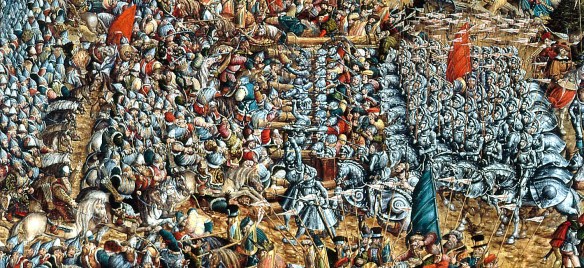Unknown painter under influence of Lucas Cranach the Elder, known as “The Master of the Battle of Orsha”
In 1512 Muscovy broke the peace by attacking Lithuania again with the aim of capturing Smolensk. In December 1512 Grand Duke Basil himself went to Smolensk, but it was ably defended and when a relief force approached the Muscovites retreated. The Polish-Lithuanian Commander, Ostrogski, ravaged the lands around Seversk and destroyed a 6,000 Muscovite force.
In September 1513 Basil returned to Smolensk with more powerful forces, and a six week siege of repeated assaults was withstood. Polish forces drove the enemy from Vitebsk and Polock and defeated a 14,000 force near Orsza thereby relieving Smolensk.
In June 1514 the Muscovites returned and on this occasion the slow response of Polish-Lithuanian forces led to the surrender of Smolensk. The Polish-Lithuanian army, of over 30,000 troops, led by Ostrogski, arrived and on the 8th September crushed the 80,000 strong Muscovite army at Orsza (8 September 1514). However this spectacular victory was not fully exploited and Smolensk could not be retaken.
Polish artillery at the battle of OrszaIn March 1515 Muscovy formed an alliance with the Livonian Knights, but failed to take Vitebsk, while Polish forces recaptured Wielkie Luki and Torpiec (1516). In 1517 the Polish expedition to Pskow ended in defeat at the siege of Opoczka while the following year brought a comprehensive victory for the Poles against the besieging Muscovites at Polock.
In 1519 three Muscovite armies devastated Lithuania as far as Krewno where the Polish-Lithuanian army was assembling. While allied Crimean Tartars attacked Lvov and Lublin. However the Muscovites failed to gain any significant results and a peace treaty was signed in 1520.
#
In the war which Moscow started in 1512, breaking the “eternal” peace of 1508, the main attack was directed against Smolensk. When the two first sieges of that strategically important White Russian city ended in failure, Vasil persuaded the envoy of Maximilian I to conclude in Moscow a treaty which, going beyond the Emperor’s intentions, pledged him to join in the struggle against Sigismund I. With Albrecht of Prussia also ready for action after the breakdown of protracted negotiations, and the Crimean Tartars as a permanent threat at the southeastern border, the situation of Poland and Lithuania indeed became critical after the fall of Smolensk in 1514. Seizing that opportunity for pressing his claims to Hungary and Bohemia, the Emperor was planning a congress on German territory where Sigismund and Vladislav would practically surrender in all controversial issues.
But only a few weeks later, in the same year, the great victory of Orsza, won by the Lithuanians under the leadership of Prince Constantine Ostrogski, the most powerful Orthodox Ruthenian magnate, assisted by Polish forces, altogether changed the situation. Welcomed even in distant Rome as a decisive victory of the Western world, that battle did not regain Smolensk, lost for almost a century, but made the Emperor decide in favor of an understanding with the Jagellonians to be negotiated at a congress which started in Pozsony (Pressburg), Hungary, where Sigismund, with his Polish and Lithuanian advisers, joined the King of Hungary and Bohemia.
That congress of 1515 can be called a first Congress of Vienna, three hundred years before the famous one, because it was concluded in the Austrian capital after Maximilian I had met his guests near the frontier. The consequences of that meeting were to prove of primary significance for the history of East Central Europe. The three monarchs, all humanists of distinction, rather liked one another upon becoming personally acquainted. The Emperor promised no longer to support either the grand prince of Moscow against Lithuania or the grand master in Prussia against Poland, but to act as a friendly mediator, advising Albrecht to pay his homage to the king and Vasil III to stop his aggressions. For these concessions made to Sigismund I, Maximilian of course expected some compensation with respect to the succession in Hungary and Bohemia. But no treaty which would guarantee that succession to the Habsburgs after the extinction of the elder branch of the Jagellonians was signed in Vienna. Only a double wedding was celebrated. Vladislav’s only son, Louis, married the Emperor’s granddaughter Mary, while Maximilian himself was married per procuram to Vladislav’s daughter Ann, acting for one of his grandsons, Charles or Ferdinand.
